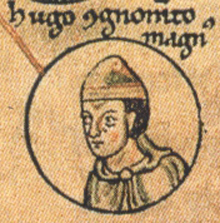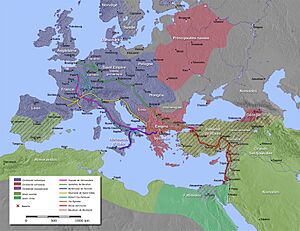Hugh, Count of Vermandois facts for kids
Quick facts for kids Hugh I |
|
|---|---|
 |
|
| Count of Vermandois | |
| Reign | 1085–1101 |
| Predecessor | Odo I |
| Successor | Ralph I |
| Born | 1057 |
| Died | 18 October 1101 (aged 44) Tarsus, Cilicia (modern-day Tarsus, Mersin, Turkey) |
| Spouse | Adelaide, Countess of Vermandois |
| Issue more... |
Elizabeth, Countess of Leicester Ralph I, Count of Vermandois |
| House | Capet |
| Father | Henry I, King of France |
| Mother | Anne of Kiev |
Hugh I (born 1057 – died October 18, 1101), also known as Hugh the Great, was an important French nobleman. He was the first count of Vermandois from the House of Capet, a powerful royal family. Hugh is best known for being one of the main leaders of the First Crusade. His nickname "the Great" might actually have come from a mistake. It was probably meant to be "the Younger," because he was the younger brother of King Philip I of France.
Contents
Early Life and Family
Hugh was a younger son of King Henry I of France and Anne of Kiev. His older brother was Philip I. Hugh became the first Capetian count of Vermandois in 1085. This happened after his brother-in-law, Odo, was removed from power because he was unable to rule. In the same year, Hugh helped William the Conqueror stop an invasion of England by the Danes.
Joining the First Crusade
In early 1096, Hugh and his brother King Philip started talking about the First Crusade. This was after they heard about the Council of Clermont, where Pope Urban II called for a holy war. King Philip could not join the Crusade because he had been excommunicated (kicked out of the Church). But Hugh was convinced to go, perhaps after seeing an eclipse of the moon in February 1096.
In late August 1096, Hugh and his army left France. They traveled through the Alps and Rome to reach Bari, a city in Italy. From Bari, Hugh planned to cross the Adriatic Sea to reach the Byzantine Empire. Most other crusaders traveled over land, but Hugh chose the sea route.
Arrival in the Byzantine Empire
Hugh's ships were possibly led by Arnout II, Count of Aarschot. When Hugh was close to the Byzantine Empire, he sent a message to the Byzantine Emperor Alexius I Comnenus. The emperor's daughter, Anna Comnena, wrote about this message in her book, the Alexiad. She called it "absurd" because Hugh demanded a grand welcome.
Know, Emperor, that I am the King of Kings, the greatest of all beneath the heavens. It is fitting that I should be met on my arrival and received with the pomp and ceremony appropriate to my noble birth.
Emperor Alexius told his nephew, John Komnenos, who was the governor of Dyrrhachium, to watch for Hugh. He also told Nicholas Maurokatakalon, the commander of the Byzantine fleet, to inform him immediately when Hugh arrived.
Meanwhile, Hugh reached the coast of Longobardi. He sent 24 messengers to the governor of Dyrrhachium. They told the governor that Hugh was coming with the "golden standard of St Peter" from Rome. They also said he was the main commander of the Frankish army and should be welcomed properly.
While sailing across the Adriatic Sea, Hugh's fleet was caught in a big storm. Most of his ships were lost. His own ship was washed ashore near Epirus. When Hugh was found, he was taken to Dyrrhachium. John Komnenos, the governor, gave him a feast and allowed him to rest. The emperor ordered that Hugh be closely watched by Manuel Boutoumites. Eventually, Hugh met the emperor. Alexius convinced Hugh to become his liegeman, which meant Hugh promised loyalty and service to the emperor.
A historian named Hans Eberhard Mayer said that Emperor Alexius was lucky. Hugh's group was the first and smallest part of the crusader army to reach Constantinople. This made them easy for Alexius to control. Alexius quietly but clearly limited Hugh's freedom. He did this until Hugh promised that any lands taken back from the Turks that used to belong to Byzantium would be returned. Also, any new lands conquered further east would be held as fiefs, meaning they would be under the emperor's rule.
Anna Comnena also wrote about a conversation between Hugh and Godfrey of Bouillon, another Crusader leader. Hugh tried to convince Godfrey to promise loyalty to Emperor Alexius. But Godfrey refused. He said Hugh had left his own country as a ruler and now acted like a slave. Hugh replied that they should have stayed home. But since they had come so far and needed the emperor's help, they should obey him.
Later Crusade and Death
After the Crusaders successfully crossed Seljuk lands, they captured the city of Antioch in 1098. After this victory, Hugh was sent back to Constantinople. His job was to ask Emperor Alexius for more soldiers and supplies. However, the emperor was not interested in sending more help.
Instead of returning to Antioch to help plan the siege of Jerusalem, Hugh went back to France. There, he was criticized for not finishing his vow as a Crusader to reach Jerusalem. Pope Paschal II even threatened to excommunicate him again.
To fulfill his vow, Hugh joined the next Crusade, known as the Crusade of 1101. But in September, he was wounded in a battle with the Turks. This battle was led by Kilij Arslan I near Heraclea. Hugh died from his wounds in October 1101 in Tarsus.
Family Life
Hugh married Adelaide, Countess of Vermandois. She was the daughter of Herbert IV, Count of Vermandois and Adele of Valois. Hugh and Adelaide had nine children together:
- Matilda, who married Ralph I of Beaugency.
- Elizabeth of Vermandois, Countess of Leicester (died 1138). She married Robert de Beaumont, 1st Earl of Leicester first, and then William de Warenne, 2nd Earl of Surrey.
- Beatrice (active around 1144), who married Hugh IV of Gournay.
- Ralph I, Count of Vermandois (died 1152). He married Eleanor of Champagne first, and then Petronille of Aquitaine.
- Constance, who married Godfrey de la Ferté-Gaucher.
- Agnes (active around 1125), who married Boniface del Vasto.
- Henry, Lord of Chaumont en Vexin (died 1130).
- Simon (died 1148).
- William (died around 1096).
Sources
|
Hugh, Count of Vermandois
Born: 1057 Died: 18 October 1101 |
||
| French nobility | ||
|---|---|---|
| Preceded by Odo |
Count of Vermandois with Adelaide 1085–1101 |
Succeeded by Ralph I |
See also
 In Spanish: Hugo I de Vermandois para niños
In Spanish: Hugo I de Vermandois para niños


